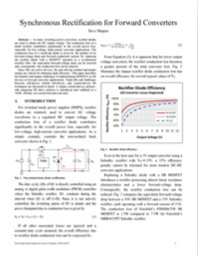Synchronous Rectification for Forward Converters
In many switching power converters, rectifier diodes are used to obtain the DC output voltage. The conduction loss of a diode rectifier contributes significantly to the overall power loss, especially for low-voltage, high-current converter applications. The conduction loss of a rectifying diode is given by the product of its forward-voltage drop and forward conduction current.
By replacing the rectifier diode with a MOSFET operated as a synchronous rectifier (SR), the equivalent forward-voltage drop can be lowered and, consequently, the conduction loss can be reduced.
Download this whitepaper to learn more.
Read More
By submitting this form you agree to Fairchild Semiconductor contacting you with marketing-related emails or by telephone. You may unsubscribe at any time. Fairchild Semiconductor web sites and communications are subject to their Privacy Notice.
By requesting this resource you agree to our terms of use. All data is protected by our Privacy Notice. If you have any further questions please email dataprotection@techpublishhub.com
Related Categories: Analog, Components, Inductors, Power, Switches, Transformers

More resources from Fairchild Semiconductor
Synchronous Rectification for Forward Converters
In many switching power converters, rectifier diodes are used to obtain the DC output voltage. The conduction loss of a diode rectifier contributes...
Fourth-Generation Field Stop IGBT with High-Performance and Enhanced Latch-Up Immunity
When tasked with developing the 4th generation 650 V rated Field Stop (FS) Trench IGBTs, Fairchild's engineers had a high bar to overcome to develo...
